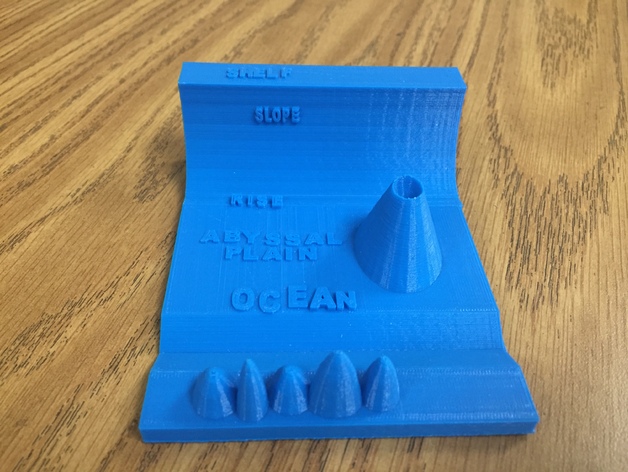
Ocean Floor Explorers
thingiverse
Students in a 5th grade classroom were learning about the different geographic features of the ocean floor. Students had to be able to identify the following features: Continental shelf, Continental slope, Continental rise, abyssal floor, seamounts, mid-Atlantic ridge, and trench. Once the students were familiar with these features they worked to create a replica of the ocean floor including each of the important features. Print Settings Printer Brand: MakerBot Printer: MakerBot Replicator (5th Generation) Rafts: Doesn't Matter Supports: Doesn't Matter Notes: *Tips & Tricks: Before printing it's important to go through each student's design to ensure that their creations are printable. For example: We often had student's who created seamounts however parts of them "floated" above the ocean floor instead of actually being connected. Doing a quick check that objects are correctly layered and designed will help immensely when it comes down to printing. We also printed multiple ocean floors on a build plate at a time. It cut down on printing time and allowed the printer to run all day instead of shorter prints that needed to constantly be started throughout the day. How I Designed This TinkerCAD Students worked on TinkerCAD to create their layers of the ocean floor. Standards CCSS Overview and Background Students learn about the different geographic layers of the ocean floor. Students need to be able to recognize the different geographic features and where they can be found in the ocean. Students learned about plate tectonics and how each feature was formed. Students need to be able to identify the following geographic features: Continental shelf, Continental slope, Continental rise, abyssal floor, seamounts, mid-Atlantic ridge, and trench. After students knew enough to identify the different features of the ocean floor they worked in TinkerCAD to design their own ocean floors. They were allowed to make the ocean floor look however they wanted as long as they had all of the above parts and they were accurately depicted. Objectives Students should be able to identify the different geologic features of the ocean floor: Continental shelf, Continental slope, Continental rise, abyssal floor, seamounts, mid-Atlantic ridge, and trench. Students should be able to design the ocean floor with the correct geographic features in terms of spacing and proportion. Standards Skills Learned (Standards): Virginia SOL: Standard Science SOL 5.6a The student will investigate and understand characteristics of the ocean environment. Key concepts include: a) geological characteristics (continental shelf, slope, rise) Common Core:http://coreknowledge.org/mimik/mimik_uploads/lesson_plans/1425/6_EarthWaterPlanet.pdf Lesson Plan and Activity In class students learn about the geography of the ocean floor unit. Throughout the unit, students identify and understand the different geologic features of the ocean floor: Continental shelf, Continental slope, Continental rise, abyssal floor, seamounts, mid-Atlantic ridge, and trench. Students log onto TinkerCAD and learn the basics of 3D design such as grouping, layering, and creating holes. Then students create a drawn draft of what they want to create and how they are going to include each feature into their ocean floor. Students need to make sure their ocean floor drawings are complete with the correct physical features and proportions. After the student’s draft is approved by the teacher they may begin working in TinkerCAD. Students use TinkerCAD and begin creating their model of the ocean floor. Once students finish the teacher needs to ensure that the creation has all of the components and is ready for printing. Duration of Lesson After students started learning about the ocean floor unit in class the actual 3D modeling and creating part took the students about an hour to complete. Preparation Before beginning in TinkerCAD students need to understand the geography of the ocean floor. They must be able to identify the different geologic features of the ocean floor: Continental shelf, Continental slope, Continental rise, abyssal floor, seamounts, mid-Atlantic ridge, and trench. Rubric and Assessment By the end of the project students should have designed the bottom of the ocean floor including its important features. Students will get full credit on their 3D creations if they ensure that their ocean floor contains each of the features and they are correctly placed. Please see the attached documents for our handouts and assessments. Here are some good ideas for lessons: https://www.cpet.ufl.edu/wp-content/uploads/2013/03/Mapping-the-Ocean-Floor-Worksheet-and-Lab-Activity.pdf References Brain Pop Intro Lesson:https://educators.brainpop.com/bp-topic/ocean-floor/ Ocean Lessons and Resources:https://sites.google.com/a/solteacher.com/olteacher-com/home/fifth-grade/fifth-grade-science-sol-5th/geological-characteristics
With this file you will be able to print Ocean Floor Explorers with your 3D printer. Click on the button and save the file on your computer to work, edit or customize your design. You can also find more 3D designs for printers on Ocean Floor Explorers.
